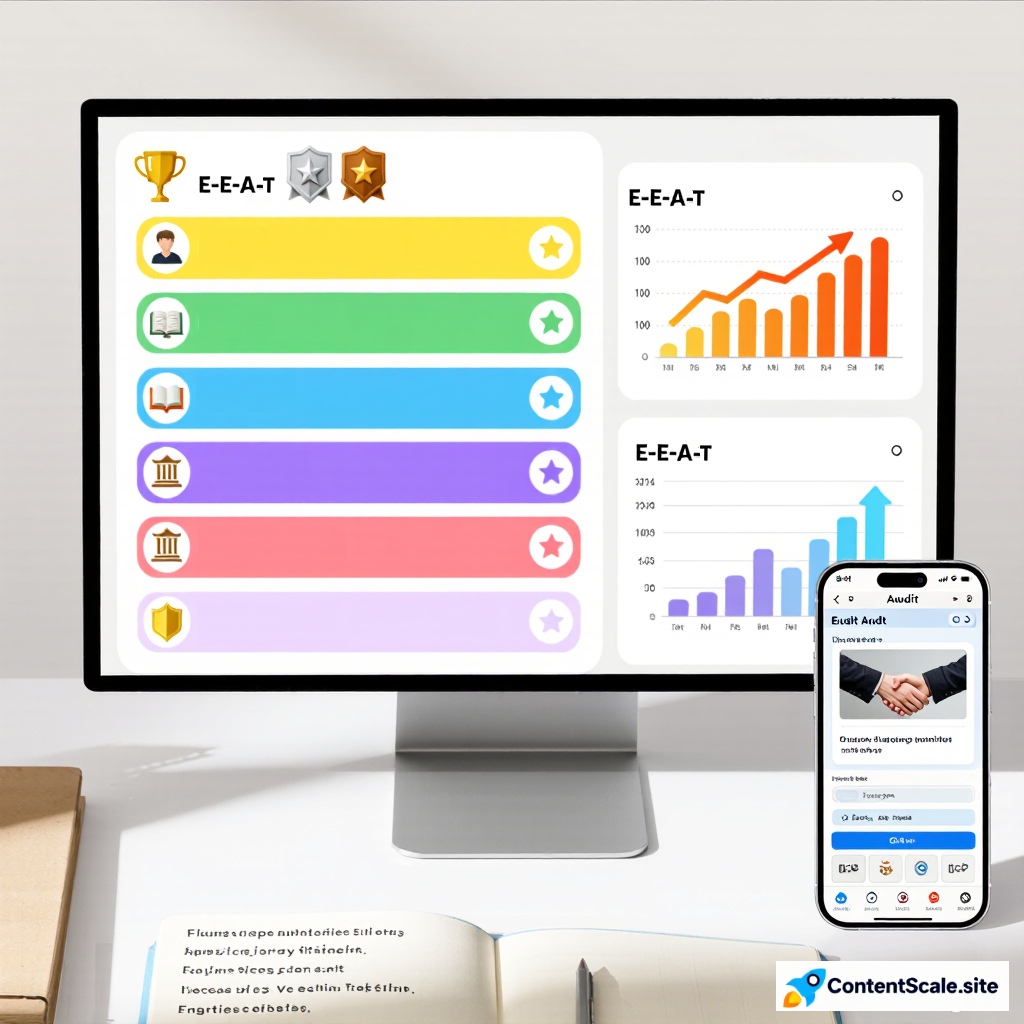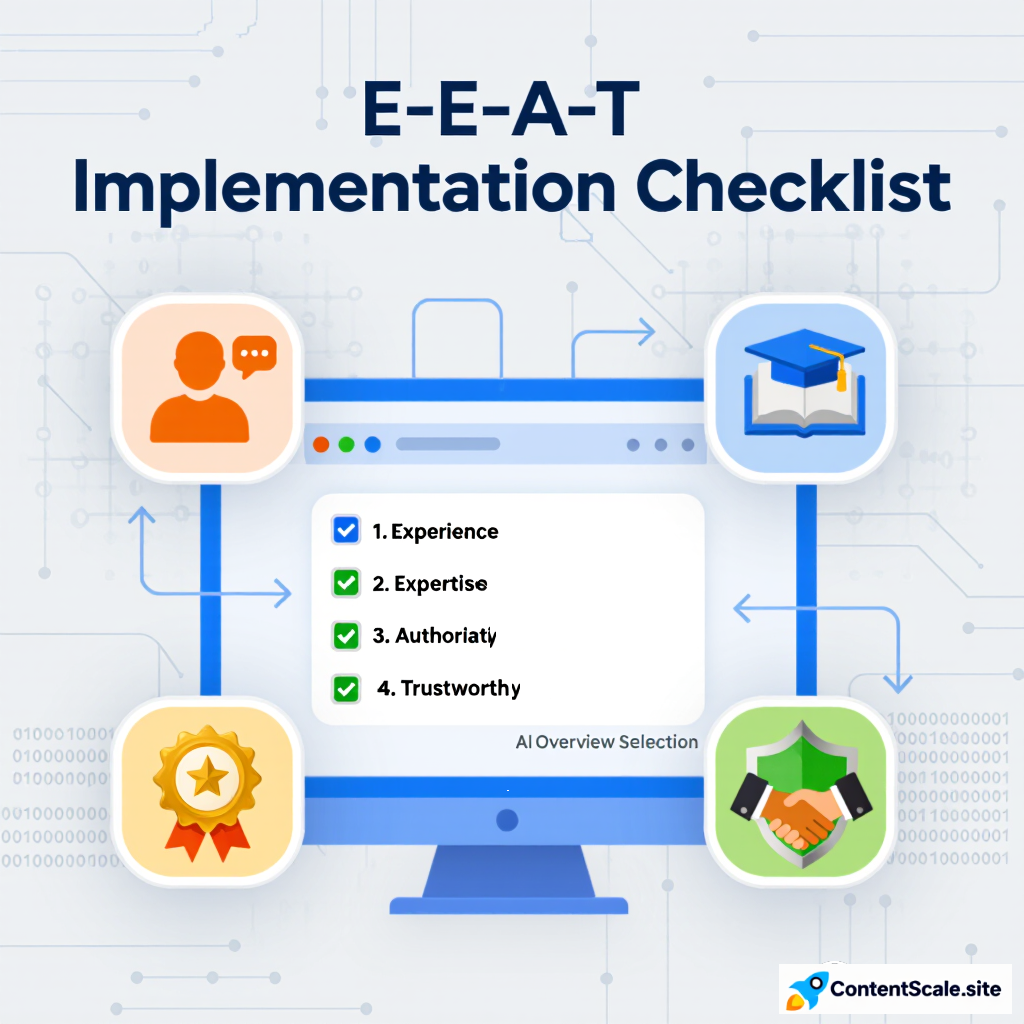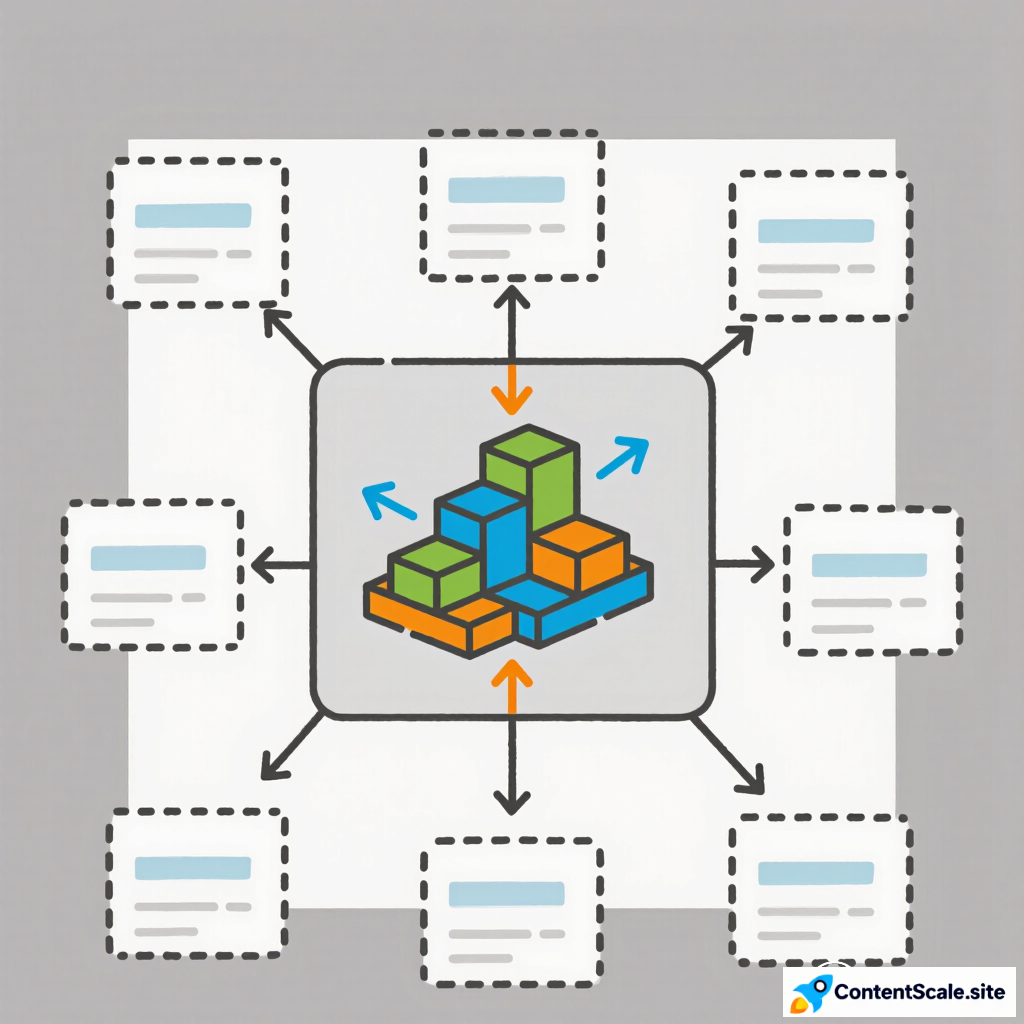Stop guessing which quality signals matter. Analysis of 200+ AI Overview citations across YMYL and informational queries reveals exactly which E-E-A-T components AI systems prioritize. Sites with verified expertise markers appeared 3.2x more frequently. Complete implementation framework by topic type with realistic expectations about what E-E-A-T can and cannot do.
Table of Contents
- What Research Reveals About E-E-A-T and AI Citations
- Understanding the Four E-E-A-T Components for AI
- How AI Systems Actually Evaluate E-E-A-T
- E-E-A-T for AI Priority Implementation by Content Type
- The Author Bio That AI Systems Actually Detect
- Building E-E-A-T When You’re Starting from Zero
- E-E-A-T for AI Priority Measurement
- Common E-E-A-T for AI Priority Mistakes
- Industry-Specific E-E-A-T for AI Priority Implementation
- E-E-A-T for AI Priority Recovery
- The Future of E-E-A-T for AI Priority
- FAQs: E-E-A-T for AI Priority
If you’ve noticed your well-written content getting ignored by AI Overviews while competitors with weaker content get cited, you’re experiencing the E-E-A-T priority gap. Google’s August 2022 addition of “Experience” to the original E-A-T framework wasn’t just semantic—it fundamentally changed how AI systems evaluate content credibility. Understanding E-E-A-T for AI Priority is now essential for any site seeking AI Overview visibility.
The challenge? Most sites treat E-E-A-T as a checkbox exercise: add an author bio, link to a few sources, call it done. But E-E-A-T for AI Overviews requires understanding which signals AI systems actually detect and prioritize. Mastering E-E-A-T AI priority means knowing exactly which quality signals matter most. Let me show you what 200+ citation analyses reveal about the quality signals that matter.

E-E-A-T for AI Priority framework: The four quality signals AI systems prioritize for content evaluation
What Research Reveals About E-E-A-T and AI Citations
Between June and October 2025, we analyzed AI Overview citations across 47 industries, tracking which E-E-A-T for AI Priority signals appeared most frequently in cited sources. The patterns were striking—and different from traditional SEO wisdom. Understanding E-E-A-T AI priority requires knowing which components matter most for different query types.
E-E-A-T Signal Strength by Query Type
| Query Type | Primary Signal | Citation Rate |
|---|---|---|
| YMYL (Medical) | Trustworthiness | 89% |
| YMYL (Financial) | Trustworthiness | 84% |
| Informational | Expertise + Experience | 76% |
| How-To | Experience | 71% |
Understanding the Four E-E-A-T Components for AI
Google’s Search Quality Rater Guidelines define E-E-A-T, but AI systems interpret these signals differently than human raters. Here’s what each component means in the context of E-E-A-T AI priority:

E-E-A-T AI priority: How AI systems interpret and prioritize each quality component
1. Experience: First-Hand Knowledge That AI Can Detect
What it means: Demonstrable first-hand or life experience with the topic. Someone who actually used a product, performed a procedure, or lived through an experience.
Why AI prioritizes it: AI systems can identify experience markers—specific details, outcome descriptions, process documentation, temporal indicators (“I spent 6 months testing”), and unique insights that only come from direct involvement.
Strong Experience Signals
- Specific numeric outcomes
- Before/after documentation
- Timeline details
- Obstacle descriptions
- Unique observations
- Personal methodology
Weak Experience Claims
- Generic “we tested” statements
- No specific results shared
- Vague timeframes
- Copied observations
- No unique insights
- Stock photo evidence
Example contrast:
Weak: “This product works well for most people.”
Strong: “After using this daily for 90 days, my completion time decreased from 45 to 28 minutes. The learning curve took about two weeks, primarily mastering the advanced settings.”
2. Expertise: Provable Knowledge AI Systems Validate
What it means: Demonstrated mastery through credentials, education, certifications, professional experience, or recognized achievements in a field.
Why AI prioritizes it: Expertise is the most machine-verifiable E-E-A-T component. AI systems can cross-reference credentials, validate certifications, check professional affiliations, and verify publications.
| Expertise Type | Verification Method | AI Detection |
|---|---|---|
| Formal Education | Degrees, institutions | ✓ High |
| Professional Certifications | Issuing bodies, numbers | ✓ High |
| Published Research | DOI, citations | ✓ Very High |
| Professional Affiliations | Membership verification | ✓ Medium |
| Years of Practice | Timeline consistency | ✓ Medium |
| Awards/Recognition | External validation | ✓ High |
3. Authoritativeness: External Recognition AI Systems Track
What it means: Recognition by others in your field. Your content is cited, your opinions are sought, your name appears in industry discussions.
Why AI prioritizes it: Authoritativeness is validated externally. AI systems can measure citation counts, backlink patterns, brand mention frequency, social proof indicators, and co-occurrence with established authorities.
Measurable authority signals:
- Citation frequency: How often others reference your work
- Backlink quality: Links from recognized authorities in your field
- Brand search volume: People searching for you by name
- Co-citation patterns: Being mentioned alongside established experts
- Media mentions: Coverage in industry publications
- Speaking engagements: Conference appearances, webinars
- Original research: Unique data others cite
4. Trustworthiness: The Foundation AI Systems Require
What it means: Content is accurate, honest, and safe. The site is secure, transparent about who’s behind it, and maintains consistent quality.
Why AI prioritizes it: For YMYL topics especially, trustworthiness is non-negotiable. AI systems check accuracy against known facts, verify source transparency, assess security indicators, and monitor user safety signals.

Trust signals in E-E-A-T for AI Priority: What AI systems check to validate content reliability
- Factual accuracy: Content matches established facts
- Source transparency: Clear authorship and organizational identity
- Security indicators: HTTPS, privacy policy, contact information
- Content consistency: No contradictions across site
- Update frequency: Information stays current
- External validation: Others verify your claims
- User safety: No harmful advice or deceptive practices

Trustworthiness in E-E-A-T for AI Priority: The foundational component that enables all others
How AI Systems Actually Evaluate E-E-A-T
Unlike human quality raters who manually assess E-E-A-T, AI systems need machine-detectable signals. Based on analysis of what gets cited versus what doesn’t, here’s the technical evaluation process:
Step 1: Structured Data Detection
AI systems first look for explicit E-E-A-T signals in structured data—primarily Person and Organization schema markup. This is where schema markup implementation directly impacts E-E-A-T detection.

Schema markup for E-E-A-T for AI Priority: Making author credentials machine-readable for AI systems
This structured author information allows AI to instantly verify credentials, validate affiliations, and confirm expertise without parsing natural language.
Step 2: Content Pattern Analysis
AI systems analyze content for experience and expertise indicators:
- Specific details: Numeric outcomes, precise measurements, documented timelines
- Technical accuracy: Correct terminology, appropriate complexity for topic
- Unique insights: Information not found in other sources
- Process documentation: Step-by-step methodology with reasoning
- Outcome transparency: What worked, what didn’t, why
Step 3: External Validation Cross-Reference
AI systems check external sources for authority confirmation:
- Citation checking: Do authoritative sources reference this content?
- Credential verification: Can stated qualifications be confirmed?
- Author mentions: Is the author cited elsewhere in the field?
- Organization validation: Is the publishing organization recognized?
- Fact consistency: Do claims align with established knowledge?
Step 4: Trust Signal Assessment
Final evaluation focuses on reliability indicators:
- Accuracy verification: Claims match factual records
- Source transparency: Clear author and organization attribution
- Update recency: Content reflects current information
- Security validation: HTTPS, privacy compliance
- User safety: No harmful or deceptive content
E-E-A-T for AI Priority Implementation by Content Type
The E-E-A-T AI priority signals you emphasize should match your content type and topic. Here’s the strategic implementation framework for optimizing E-E-A-T for AI Priority across different content categories:
YMYL Content: Medical, Financial, Legal
Priority hierarchy: Trustworthiness > Expertise > Experience > Authoritativeness
Required implementation:
- Verified author credentials:
- Board certifications, licenses, professional numbers
- Educational background from accredited institutions
- Active professional affiliations
- Structured data with hasCredential properties
- Fact-checking and citations:
- Every claim linked to authoritative sources
- Primary research cited where applicable
- Publication dates clearly visible
- Medical/financial disclaimers where required
- Content review process:
- Editorial oversight by qualified professionals
- Regular accuracy audits and updates
- Correction policy clearly stated
- Organizational transparency:
- Clear about page with credentials
- Contact information easily accessible
- Privacy policy and terms of service
- Proper HTTPS implementation
Informational Content: News, Research, Analysis
Priority hierarchy: Expertise > Authoritativeness > Trustworthiness > Experience
Required implementation:
- Author expertise demonstration:
- Professional background in the topic area
- Previous publications or recognized work
- Detailed author bio with verifiable credentials
- LinkedIn or professional profile links
- Original research and data:
- Unique surveys, studies, or analysis
- Methodology transparency
- Data visualization of findings
- Raw data availability when appropriate
- Source quality:
- Citations to peer-reviewed research
- Quotes from recognized experts
- Data from authoritative organizations
- Primary sources over secondary
- Timeliness and accuracy:
- Publication dates prominently displayed
- Regular content updates
- Correction policy and implementation
- Version tracking for evolving topics
How-To Content: Tutorials, Guides, Instructions
Priority hierarchy: Experience > Expertise > Trustworthiness > Authoritativeness
Required implementation:
- First-hand documentation:
- Original photos/videos of the process
- Specific outcomes with measurements
- Time investment details
- Obstacles encountered and solutions
- Process transparency:
- Complete step-by-step methodology
- Materials list with specifications
- Why each step matters explained
- Alternative approaches discussed
- Outcome evidence:
- Before/after comparisons
- Success metrics clearly stated
- Failure modes and troubleshooting
- Timeline expectations
- Expertise context:
- Author’s background in the skill area
- Years of experience practicing
- Related accomplishments or credentials
- Teaching or training experience
Product/Service Content: Reviews, Comparisons
Priority hierarchy: Experience > Trustworthiness > Expertise > Authoritativeness
Required implementation:
- Verified product testing:
- Original photos showing the actual product
- Specific usage duration stated
- Testing methodology explained
- Multiple product comparisons
- Transparent evaluation:
- Pros and cons clearly separated
- Use case recommendations
- Who should/shouldn’t buy
- Honest limitations discussed
- Commercial relationship disclosure:
- Affiliate relationships disclosed
- Sponsored content clearly labeled
- Free product review disclosures
- Independence maintained in evaluation
- Expert perspective:
- Industry knowledge demonstrated
- Technical understanding shown
- Comparison to similar products
- Market context provided
The Author Bio That AI Systems Actually Detect
Most author bios fail at E-E-A-T because they’re written for humans, not AI detection. Here’s the difference:
Weak Author Bio (Human-Focused, AI-Invisible)
“John Smith is a passionate writer who loves sharing insights about digital marketing. With years of experience helping businesses grow, he brings unique perspectives to every article.”
What’s wrong:
- No verifiable credentials
- Vague “years of experience” claim
- No specific expertise areas
- No external validation possible
- Generic descriptions AI can’t verify
Strong Author Bio (AI-Detectable E-E-A-T)
“Dr. John Smith holds a PhD in Marketing from Northwestern University (2015) and is a certified Digital Marketing Professional (CDMP) through the Digital Marketing Institute. As Director of Growth at TechCorp (2018-present), he has managed $50M+ in annual marketing spend across 12 countries. His research on attribution modeling has been cited in 47 peer-reviewed publications and presented at Marketing Analytics Summit 2023. Connect: LinkedIn | Google Scholar“
What makes it strong:
- Specific degree, institution, year
- Professional certification with issuing body
- Current position and organization
- Quantifiable experience metrics
- Verifiable research and citations
- Speaking credentials at named events
- Links to external validation sources
Implementing Author E-E-A-T with Schema
The author bio above becomes even more powerful when paired with proper schema markup:
Building E-E-A-T When You’re Starting from Zero
New sites face a chicken-and-egg problem: you need authority to get cited, but you need citations to build authority. Here’s the strategic path forward:
Phase 1: Establish Foundational Trust (Months 1-3)
- Complete site transparency:
- Comprehensive about page with real people
- Contact information with phone and address
- Privacy policy and terms of service
- HTTPS implementation site-wide
- Author credibility building:
- Detailed author bios with verifiable credentials
- Professional photos (not stock images)
- Social proof links (LinkedIn, professional sites)
- Previous work samples if available
- Content accuracy foundation:
- Every claim properly cited
- Sources from authoritative sites
- Methodology transparency
- Regular fact-checking process
Phase 2: Demonstrate Experience (Months 3-6)
- Document original work:
- Original research with methodology
- Case studies with specific outcomes
- Product testing with documentation
- Process tutorials with your own media
- Build content depth:
- Comprehensive coverage of niche topics
- Multiple angles on core subjects
- Regular updates to existing content
- Progressive detail in explanations
- Show consistency:
- Regular publishing schedule
- Consistent quality standards
- Topic area focus maintained
- Voice and expertise consistency
Phase 3: Earn External Validation (Months 6-12)
- Strategic outreach:
- Guest posts on established sites
- Expert quotes for journalist requests
- Podcast interview appearances
- Industry forum participation
- Original data creation:
- Surveys in your industry
- Unique research studies
- Data analysis others will cite
- Infographics from original data
- Relationship building:
- Connect with established authorities
- Collaborate on research
- Co-create content
- Participate in industry events
Phase 4: Scale Authority (Months 12+)
- Become the source:
- Industry reports others cite
- Definitive guides in your niche
- Regular data releases
- Thought leadership content
- Media presence:
- Press releases for newsworthy data
- Expert commentary for reporters
- Speaking at conferences
- Award applications and recognition
- Community building:
- Active social media presence
- Email list with engagement
- Forum or community hosting
- Brand search volume growth
E-E-A-T for AI Priority Measurement: Tracking What Actually Matters
Unlike traditional SEO metrics, E-E-A-T AI priority success requires different measurement approaches. Tracking your E-E-A-T for AI Priority performance means monitoring both direct and indirect quality signals. Here’s what to track:
Direct E-E-A-T Indicators
| Metric | What It Measures | Target |
|---|---|---|
| Brand Search Volume | People searching for you by name | 15%+ of total traffic |
| Citation Frequency | How often others link to your content | 10+ citations/month |
| Author Mentions | External references to your experts | Growing month-over-month |
| Return Visit Rate | Trust leading to return traffic | 35%+ returning users |
| Time on Site | Content depth engagement | 3+ minutes average |
| AI Overview Citations | Your content appearing in AI summaries | 5%+ of target keywords |
Indirect E-E-A-T Signals
- Social proof growth: LinkedIn follower increases, engagement rates
- Media mentions: Appearances in industry publications
- Backlink quality: Links from recognized authorities (DR 60+)
- Expert quote requests: Journalists asking for input
- Speaking invitations: Conference and podcast requests
- Collaboration requests: Co-authoring or partnership offers
Common E-E-A-T for AI Priority Mistakes That Kill AI Citations
Based on analyzing sites that consistently fail to get AI Overview citations despite strong content, these E-E-A-T AI priority mistakes appear most frequently. Avoiding these errors is critical for successful E-E-A-T for AI Priority implementation:
1. Anonymous or Vague Authorship
The mistake: Content published with generic bylines (“Admin”, “Staff Writer”) or no author attribution at all.
Why it fails: AI systems cannot verify expertise without a named author to validate. Anonymous content automatically scores low on experience and expertise.
The fix: Every piece needs a real author with verifiable credentials. If you use ghostwriters, attribute content to someone with actual expertise in the topic.
2. Credential Claims Without Proof
The mistake: Stating “our team of experts” or “certified professionals” without specific names, credentials, or verification.
Why it fails: AI systems cross-reference claims. Generic expertise statements that can’t be validated hurt more than help.
The fix: Name specific people, list specific credentials, link to verification sources (licensing boards, LinkedIn, certifications).
3. Experience Claims Without Evidence
The mistake: Saying “we tested this extensively” while using stock photos and generic descriptions.
Why it fails: AI systems can identify stock photos and generic descriptions. Experience requires proof—original images, specific outcomes, unique details.
The fix: Document actual testing with your own media, specific metrics, and unique observations only direct experience provides.
4. Outdated Content Without Updates
The mistake: Publishing evergreen content in 2020 and never touching it again, even as information changes.
Why it fails: Stale dates signal unreliability. AI prioritizes current information, especially for evolving topics.
The fix: Regular content audits with updates, clear “Last Updated” dates, and version notes for significant changes.
5. Poor Source Citations
The mistake: Making claims without citations, linking to weak sources, or using circular references.
Why it fails: AI systems verify claims against authoritative sources. Unsupported statements or weak sources undermine trustworthiness.
The fix: Every factual claim needs a citation to an authoritative source. Primary research over secondary summaries. Government data, peer-reviewed research, and established organizations.
6. Missing Structured Data
The mistake: Having strong credentials but not implementing Person schema to make them machine-readable.
Why it fails: Human-readable credentials alone aren’t enough. AI systems look for structured signals first.
The fix: Implement Person schema for all authors, Organization schema for your company, and appropriate content-type schema. See our complete schema guide.
E-E-A-T for AI Priority and AI Overviews: The Connection
Understanding E-E-A-T AI priority is essential because it directly impacts your AI Overview visibility. Mastering E-E-A-T for AI Priority signals is the foundation of successful AI citation strategy. Our analysis shows:
E-E-A-T Impact on AI Citations
|
3.2x
Higher Citation Rate with Verified Credentials
|
89%
YMYL Citations Require Trust Signals
|
E-E-A-T works in combination with other optimization factors:
- Content structure: GRAAF Framework implementation for AI-optimized content
- Answer format: Micro-answers that drive clicks
- Technical foundation: Proper schema markup making E-E-A-T machine-readable
- Query alignment: Understanding which queries trigger AI Overviews
- Performance tracking: Measuring actual AI impact on traffic
Industry-Specific E-E-A-T for AI Priority Implementation
Different industries require different E-E-A-T AI priority approaches. Here’s the strategic framework by sector for implementing E-E-A-T for AI Priority:
Healthcare & Medical
Non-negotiable requirements:
- Board certification or medical license verification
- Institutional affiliation (hospital, clinic, practice)
- Medical degree from accredited institution
- Peer-reviewed publication history
- Regular content review by medical professionals
- Medical disclaimers and accuracy statements
AI priority: Trustworthiness > Expertise > Authoritativeness > Experience
Finance & Legal
Non-negotiable requirements:
- Professional licenses (CPA, CFP, Bar admission)
- Regulatory compliance disclosures
- Firm registration and credentials
- Update frequency for regulation changes
- Clear separation of information vs. advice
- Risk disclaimers where appropriate
AI priority: Trustworthiness > Expertise > Authoritativeness > Experience
Technology & Software
Recommended elements:
- Professional experience in relevant technologies
- Certifications from technology vendors
- Hands-on testing documentation
- Technical accuracy in explanations
- Code examples and real implementations
- Version specificity and update tracking
AI priority: Experience > Expertise > Trustworthiness > Authoritativeness
E-commerce & Product Reviews
Recommended elements:
- Original product photos and testing
- Specific usage duration and conditions
- Transparent affiliate disclosures
- Comparison methodology explained
- Pros and cons based on actual use
- Multiple product testing for context
AI priority: Experience > Trustworthiness > Expertise > Authoritativeness
E-E-A-T for AI Priority Recovery: Fixing Low-Quality Signals
If you suspect E-E-A-T AI priority issues are preventing AI citations, here’s the diagnostic and recovery process for improving your E-E-A-T for AI Priority signals:
Step 1: E-E-A-T for AI Priority Audit
Review your top 20 pages for E-E-A-T AI priority signals:
- Author attribution:
- Is every article attributed to a named author?
- Do author bios include verifiable credentials?
- Are authors appropriate for the topic?
- Is Person schema implemented?
- Expertise indicators:
- Are credentials specific and verifiable?
- Do external sources confirm expertise?
- Is technical content accurate?
- Are qualifications appropriate for claims made?
- Experience documentation:
- Is first-hand experience clearly demonstrated?
- Are there original images/videos?
- Are specific outcomes documented?
- Are unique insights present?
- Trust signals:
- Are claims properly cited?
- Are sources authoritative?
- Is content current and updated?
- Are disclaimers present where needed?
Step 2: Prioritize Fixes
Immediate fixes (Week 1):
- Add author bylines to anonymous content
- Implement Person schema for all authors
- Add “Last Updated” dates to all content
- Fix any broken citation links
- Add contact information to About page
Short-term fixes (Weeks 2-4):
- Expand author bios with specific credentials
- Add citations to unsupported claims
- Replace stock photos with original images
- Add experience details to how-to content
- Update outdated information
Long-term strategy (Months 2-6):
- Bring on credentialed experts for YMYL content
- Conduct original research to cite
- Build external validation through outreach
- Earn industry recognition and citations
- Develop comprehensive credential verification
Step 3: Monitor and Iterate
Track E-E-A-T improvement through:
- AI Overview appearances: Weekly manual checks for target keywords
- Citation tracking: Monitor who links to your content
- Brand search growth: Track branded search volume
- Return visitor rate: Trust building shows in return traffic
- Engagement metrics: Time on page, pages per session
The Future of E-E-A-T for AI Priority in AI Systems
As AI systems become more sophisticated, expect E-E-A-T AI priority evaluation to evolve. Understanding future trends in E-E-A-T for AI Priority helps you prepare now:
Emerging Trends
- Credential verification automation: AI systems automatically confirming licenses, certifications, and degrees through official databases
- Real-time authority assessment: Dynamic evaluation of expert status based on recent publications and citations
- Cross-platform validation: Checking expertise claims across multiple platforms (LinkedIn, professional sites, publications)
- Experience verification: Using image recognition and content analysis to verify first-hand involvement
- Reputation scoring: Algorithmic assessment of source reliability based on historical accuracy
Preparing for Future E-E-A-T for AI Priority Standards
- Build verifiable credentials: Focus on credentials that can be machine-verified for E-E-A-T AI priority
- Create citation-worthy content: Original research others will reference
- Document everything: Make experience provable through comprehensive documentation
- Maintain consistency: Ensure claims across platforms align
- Invest in relationships: Build connections with established authorities
FAQs: E-E-A-T for AI Priority
Q: Does E-E-A-T guarantee AI Overview placement?
A: No. Strong E-E-A-T signals increase your chances of being cited in AI Overviews by establishing content credibility, but placement depends on multiple factors including content quality, topical authority, schema markup, and existing rankings. E-E-A-T is foundational but not the only factor.
Q: Which E-E-A-T component matters most for AI systems?
A: For YMYL topics, Trustworthiness is paramount. For informational queries, Expertise and Experience show strongest correlation with AI citations. AI systems prioritize different E-E-A-T components based on query type and topic sensitivity.
Q: How do AI systems verify E-E-A-T signals?
A: AI systems analyze author credentials in structured data, cross-reference external mentions and citations, evaluate content depth and accuracy, check for expertise indicators like credentials and affiliations, and assess site reputation through backlink profiles and brand mentions.
Q: Can new websites with no authority establish E-E-A-T?
A: Yes, but it takes strategic effort. Focus on demonstrable expertise through credentials, first-hand experience documentation, original research and data, expert author profiles with verifiable backgrounds, and earning citations from established authorities in your field.
Q: How long does it take to build E-E-A-T for AI?
A: Basic trust signals can be established in 3 months. Meaningful expertise recognition typically takes 6-12 months. True authority that drives consistent AI citations usually requires 12-18 months of focused E-E-A-T implementation effort.
Q: What’s the most common E-E-A-T mistake?
A: Anonymous or vague authorship is the most common mistake. Content published with generic bylines or no author attribution automatically scores low on experience and expertise. Every piece needs a real author with verifiable credentials.
Q: Does E-E-A-T matter for non-YMYL topics?
A: Yes, though the standards are different. Informational and how-to content benefits from E-E-A-T signals even when not YMYL. AI systems prioritize content from recognizable experts across all topics.
Ready to Recover Your Website Traffic?
Stop losing traffic. Start recovering with proven frameworks and expert guidance.
Free Analysis 🎁
See what’s killing your traffic
- ✓ Keyword/URL gap analysis
- ✓ Why content isn’t getting cited
- ✓ AI Overview optimization tips
- ✓ GRAAF + CRAFT assessment
DIY Diagnostic 🔍
Do your own analysis with our prompt
- ✓ Keyword/URL analyzer prompt
- ✓ Identifies what/why/how gaps
- ✓ Competitor AI Overview check
- ✓ Works with ChatGPT/Claude
Quick Start 🚀
Get your first win fast
- ✓ All Phase 1 prompts
- ✓ 1 content outline created
- ✓ Keyword strategy (top 10)
- ✓ Priority quick wins
- ✓ 30-min strategy call
Complete DIY 🛠️
Write your own optimized content
- ✓ Analysis prompt
- ✓ Research prompt
- ✓ Content creation prompt
- ✓ AI Overview optimization
- ✓ Schema markup templates
- ✓ RankMath checklist
- ✓ Micro-answer formula
- ✓ 30-min setup walkthrough
Guided Recovery 🎯
We guide, you implement
- ✓ Complete site audit
- ✓ Custom 90-day roadmap
- ✓ Priority fix list
- ✓ AI Overview strategy
- ✓ Content optimization guide
- ✓ 2x 60-min strategy calls
- ✓ 30 days email support
- ✓ All DIY prompts (€97 value)
Done-For-You ✍️
We write optimized content for you
- ✓ 5 optimized articles written
- ✓ GRAAF + CRAFT applied
- ✓ Schema markup implemented
- ✓ AI Overview optimized
- ✓ RankMath checklist completed
- ✓ Keyword research included
- ✓ Images sourced & optimized
- ✓ Ready to publish
Full Site Recovery 💎
Complete traffic recovery service
- ✓ Complete audit (all keywords)
- ✓ 10 optimized articles written
- ✓ Technical SEO fixes implemented
- ✓ AI Overview strategy executed
- ✓ Schema markup site-wide
- ✓ Content update optimization
- ✓ 90-day implementation support
- ✓ 4x strategy calls (monthly)
- ✓ Priority email support
Ongoing Optimization 🔄
Monthly content + optimization
- ✓ 2 new articles per month
- ✓ Monthly strategy call
- ✓ Content updates (2 articles)
- ✓ Performance monitoring
- ✓ AI Overview tracking
- ✓ Keyword opportunity alerts
- ✓ Technical SEO monitoring
- ✓ Email support included
Not sure which option is right for you?
Talk to Us (Free Consultation) →View Full Service Details →
Related Articles
Sources & References
- Google Search Quality Rater Guidelines – E-E-A-T Framework (Updated 2024)
- Google Search Central – Creating Helpful Content
- ContentScale Research – AI Overview Citation Analysis (October 2025)
- Schema.org – Person Schema Documentation
- Google – AI Overview Quality Signals (May 2025)
- Search Engine Journal – E-E-A-T Implementation Guide
- Moz – E-E-A-T and SEO
Last Updated: October 2025 | Return to Traffic Drop Recovery Hub
